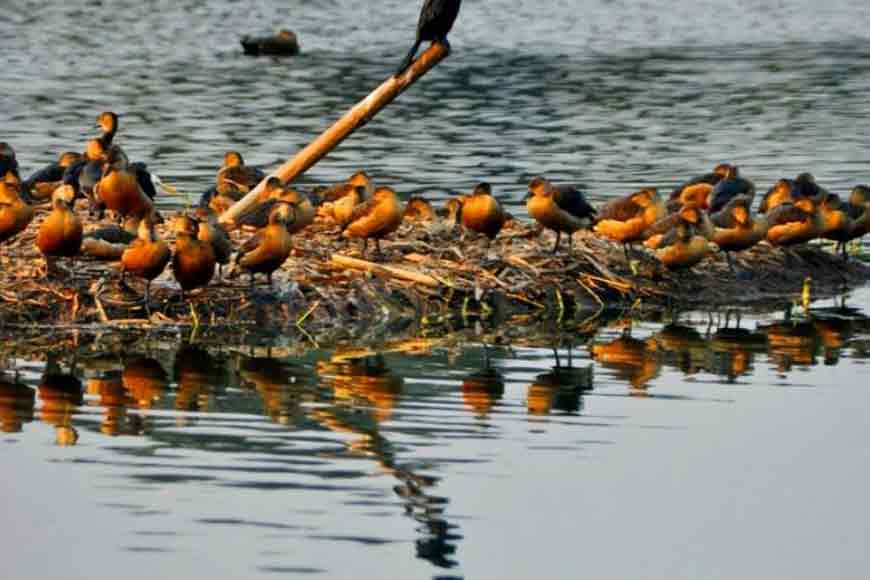Where have all the birds gone? - GetBengal story

Bengal's skies long for the flutter of migratory wings
The misty mornings no more bear the cacophony of different winged species at the huge Santragachhi Jheel on the periphery of Greater Kolkata, nor do the flutter and shrill cries of our feathered friends encourage shutter-happy birdwatchers of Purbasthali or Bortir Beel, to display their wonderful and colourful shots of rare birds that have traversed miles to come to Bengal. Almost the same picture in the heart of the city, at Rabindra Sarovar, at the water bodies of Alipore Zoo, or even Gajoldoba of North Bengal. It seems our migratory friends have forgotten our land of ponds, rivers, lakes, canals and hundreds of water bodies. But where are the water bodies? Today we stand in the middle of concrete jungles, be it the city, or the districts, as far as the eyes stretch, depriving us of the annual winter bird fest that Bengal could proudly boast of.

As bird enthusiast and photographer Urvashi Basu says: “I usually go to Gajoldoba, Santragachhi and Baruipur during ‘migratory bird season’ in winter every year and Rabindra Sarobor and Rajarhat all year through. But every year I can see a significant fall in numbers as well as the variety of species that used to come in abundant numbers. The reasons can vary from natural disasters like the Sikkim and North Bengal floods to unplanned urbanisation around water bodies, and dumping of plastics and other disposal wastes in and around the lakes. Climate change and loss of habitat are important causes too.”

True as Basu says, a recent bird census conducted a few weeks back at the Santragachhi Jheel shows a fall in the number of migratory birds this year from 5700 plus to less than 4800, despite the winter setting in well in West Bengal this year. Durbar Ghosh who lives in Howrah and runs an organisation called Birder’s Quest to save the migratory birds from being hunted feels: “When you convert farmlands and small canals that feed these farmlands on the fringes of any city to a concrete jungle, you cannot expect migratory birds to nest in such an area. Where will they get the food from, be it insects, aquatic animals, fishes, etc? Over the past few years, uncontrolled urbanisation has taken place around Calcutta and Howrah. The water bodies like Santragachhi Jheel have now been converted into a mere isolated pond-like structure, where are the extensions it had before? Surroundings we see only buildings, not even greenery that can be a natural habitat for both birds and their prey.”
Naturalists and bird-watchers claim this year another spoilsport has been Cyclone Dana and a late onset of winter, which have barred the migratory birds from Eurasian and Himalayan regions from flocking to West Bengal’s sanctuaries. With minimum temperatures dipping below 15 degrees Celsius, the arrival of such birds in the state is seen in huge numbers, though they usually arrive in mid-September. This year the arrival of winter in West Bengal was delayed due to cyclone Michaung. As per Ghosh, “The numbers of migratory birds, including both aquatic and terrestrial birds, that have arrived in the state this year is pretty low.”

Two types of migratory birds come to Bengal --- Trans-Himalayan species that come from Eurasian regions and local migratory birds that come from other parts of the country. Some are also passage migratory birds that stay briefly in West Bengal as a stopover and fly to their destinations. Most migratory birds found in West Bengal come from Eurasian regions such as Russia, China, Kazakhstan, and Mongolia and surrounding areas like Northern pintail, Gadwall, Ferruginous Duck, Common teal, and Garganey. Waders like Curlew and the Great Knot are also spotted.

Urvashi Basu says: “Nowadays many species do not arrive. Mostly we see Fulvous Whistling-duck, Sandpipers, Ferruginous Pochard, Comb Duck and the more common Gadwall, Garganey, Common Moorhen, Cotton Pygmy Goose. The same story of the loss of species is reflected from across the state. Take for example Purulia’s Saheb Bandh, the huge reservoir built during the British era that was restored and cleaned repeatedly as West Bengal Chief Minister Hon’ble Mamata Banerjee was keen to convert this waterbody into a Birder’s Paradise, has lost its zeal. Nihar Modak, who resides in Purulia says: “We have seen the decline of this waterbody over the years. Despite the efforts of the State Forest Department to clean the place, the locals do not help. Rather they use it as a dustbin, throwing anything and everything from plastic waste to oil waste that comes from numerous motor repairing shops on its fringes. Also, the entire water body is almost infested with Water Hyacinth growth that impedes oxygen flow and leads to the decline of aquatic life. How can you expect any migratory bird to come to this place anymore?”

“I went to Saheb Bandh recently, I could see only a few Purple Heron, Water Cocks, Common Teals and Purple Moorhens. No other species have arrived this year. Pollution is killing the birds. Even locals have no awareness. I have even heard some people illegally catch these birds at night and consume their meat,” says avid birdwatcher Jayeeta Chowdhury. Migratory birds usually roost throughout the day and forage at night. They do not travel far for food as they need to conserve energy. If concrete jungles take over their foraging grounds due to thoughtless urbanisation, then automatically migratory birds will turn away. Though the shifting of foraging grounds is a big issue, global warming in recent years has posed a bigger danger. However most environmentalists believe local issues like pollution should be immediately addressed, or else a time might come when the migratory birds will vanish from Bengal.










